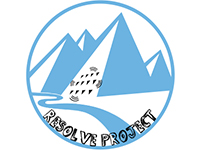The RESOLVE project
Over the last few years, wide areas of sciences involved with large-scale data gathering have started to go through a technological revolution. This is particularly true for Earth sciences, and especially geophysics, which can now benefit from continuous data acquisition by very dense arrays, allowing 4D acquisition. These sensor deployments were nearly inconceivable only 10 years ago, and up to very recent years, they were limited to expensive geophysical experiments funded by oil & gas industry. However, technological developments have changed things recently, and academic institutions can now record experimental data with hundreds of geophysics sensors at an affordable price. These sensors are autonomous and wireless, which paves the way for high-resolution geophysical imaging and monitoring in a wide range of applications sharing important societal issues.
RESOLVE aims at combining multi-physics sensors, which will make refine quantitative interpretations for the state and role of fluids in sub-surface geophysics problems. To reach this goal, RESOLVE gathers a multi-disciplinary team that is composed of geophysicists, physicists and engineers that are experts in wave physics, geophysical imaging, electromagnetic theory, and massive data processing. The approach of the RESOLVE project is the following :
- to build a multi-instrumental platform of geophysical sensors (seismic and electric) ;
- to develop joint quantitative interpretation using joint inversion and data fusion algorithms, leading to high-resolution spatial characterization and continuous monitoring of dynamic processes ;
- to apply this methodology at different scales in geothermal, natural hazard, water resources and glaciology dynamic processes.
Two main ingredients make this ambitious and original project now possible at Université Grenoble Alpes (UGA) :
- The possibility to build at an affordable price a multi-instrument platform with a significant number of seismic and electric sensors, providing a dense spatial distribution of geophysics measurements in continuous acquisition allowing both 3D active (with sources) and 4D passive acquisitions.
- The combined expertise of specialists at UGA from different fields that are willing to work together in the frame of multi-disciplinary collaborative research.
Updated on 28 October 2020


